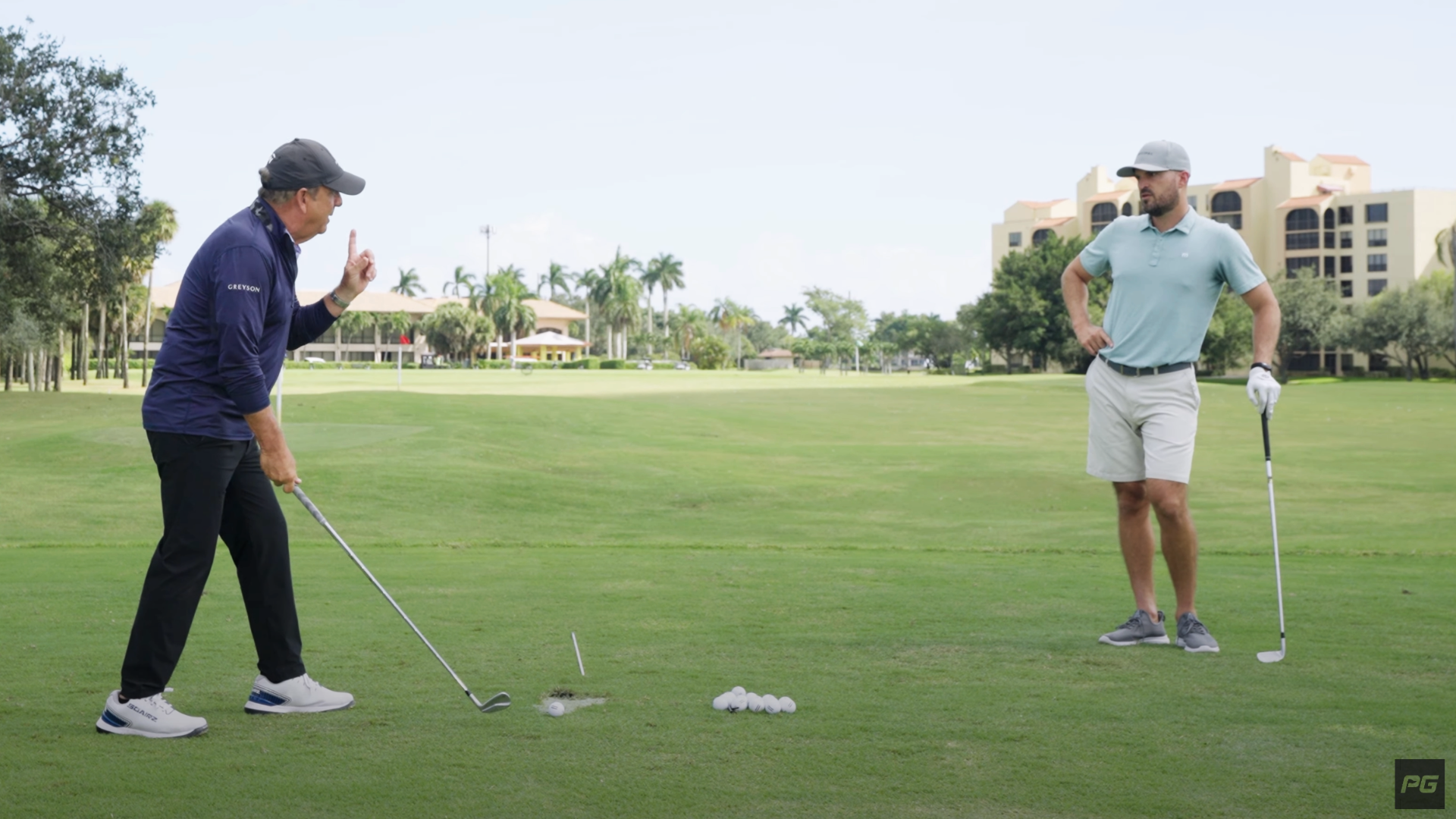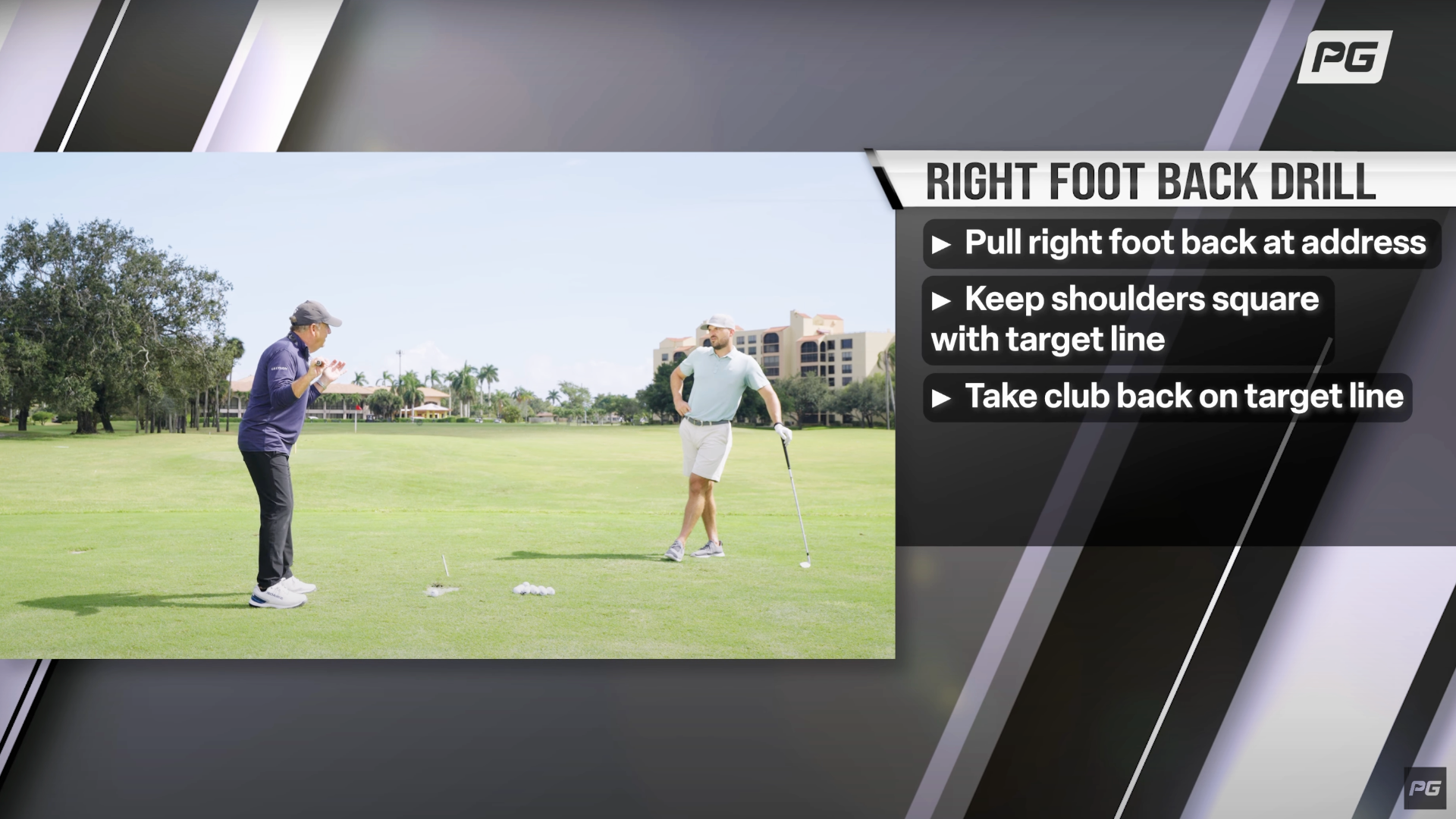
Golf is often regarded as a game of precision and finesse, one that demands constant improvement in various aspects of your swing. This includes the regular practice of various drills, whether it’s for gaining distance or fixing a slice.
In our recent YouTube video, Performance Golf coach Eric Cogorno is joined by Rick Smith to show off the “Right Foot Back Drill,” the perfect practice drill for any level of golfer to improve their ball compression.
Today, we’ll delve into the intricacies of this golf drill, explore its two-step process, and uncover insights from the experienced hands of Smith, a seasoned PGA tour coach who has guided the swings of legends like Jack Nicklaus and Phil Mickelson.
The Right Foot Back Drill: Unveiling the Two-Step Mastery
This drill stands out for its simplicity and effectiveness, breaking down into a two-step process that can transform your iron play, improving both distance and ball flight control. Be sure to reference the YouTube video if needed, but we’ll break down these steps here!
Step 1: Club Inside Motion
To initiate the drill, position yourself with the club inside and your right foot pulled back. This seemingly subtle adjustment holds the key to addressing a common issue faced by golfers – the tendency to go over the top during the swing.
Rick Smith, with over 40 years of coaching experience, says that 90% of golfers struggle with this problem. The typical approach involves setting up square, making the swing, and attempting to correct the path of the arms; but often, the body motion goes awry.
The Right Foot Back Drill challenges this conventional method. The closed aim of the right foot creates space for the arms to work from the inside during the swing. It’s not about aiming to the right; instead, it’s about aiming closed.
This adjustment prevents common pitfalls, such as letting the club whip inside.
Step 2: Torso Motion
Moving on to the second step, we’re shifting focus to the torso. The right foot back stance creates a unique dynamic, allowing your chest to be initially behind the ball at the top of the swing. To harness the full potential of the drill, visualize your chest rotating around your left leg.
This creates a sensation of turning level through the ball, leading to a more powerful and controlled impact.
This rotational aspect of the drill relies on finding the forward post with the left leg, creating a stable platform for the torso rotation, allowing for not only the more powerful and controlled impact as mentioned, but also more consistent.

Insights from Rick Smith: Coaching Legends and Successful Players
Having coached iconic players like Jack Nicklaus, Phil Mickelson, and Rocco Mediate, Smith has a treasure trove of success stories linked to this compression drill.
For more than four decades, Smith has witnessed the transformative power of the Right Foot Back Drill, particularly for slicers who struggle with an over-the-top swing. The drill not only corrects the swing path but also enhances power and ball control.
Key Points and Tips for Success
As with any golf drill, the devil lies in the details.
These key tips will help you compress the ball correctly:
- Avoid Letting the Club Whip Inside: Despite the added room created by the right foot back, it’s crucial not to let the club whip inside during the swing. Maintaining control over the club’s path ensures a clean and powerful strike.
- Find the Forward Post: The rotational aspect of the drill relies on finding the forward post with the left leg. This creates a stable platform for the torso rotation, allowing for consistent and accurate ball contact.
- Rotate Over the Forward Leg: As you complete the swing, focus on rotating your torso over the forward leg. This movement, combined with the initial inside motion of the club, contributes to the desired ball compression.
Results and Impact: Transformative Changes in Swing Path
The best part about this practice drill is its ability to initiate immediate changes in the swing path and ball flight. As Smith notes, slicers can experience a significant swing path change of 4 to 5 degrees simply by incorporating this drill into their practice regimen.
Eric Cogorno also shares his positive experience with the drill, saying the ball flight pattern became more predictable, and the satisfying sound of a well-compressed iron shot became a regular occurrence. It’s not just about addressing swing path issues – it’s about unlocking the true potential of your iron play.
The Importance of Golf Drills for Lasting Improvement
It’s clear that this seemingly straightforward adjustment can be a game-changer for golfers of all skill levels. Whether you’re struggling with a slice, seeking more power, or aiming for crisper ball contact, this drill offers a quick and straightforward solution.
Remember to focus on the key elements – club inside motion, finding the forward post, and torso rotation. Embrace the awkwardness, persist through initial challenges, and watch as your swing transforms, leading to improved ball compression and overall golf performance.
In the realm of golf, where fundamentals are often debated, it’s important to try various drills out for yourself, and see what works best for your style. Remember, it’s not just a drill; it’s a pathway to mastering the art of ball compression with your irons.
Don’t forget to subscribe to the Performance Golf YouTube channel for more helpful drills and practice guides.

